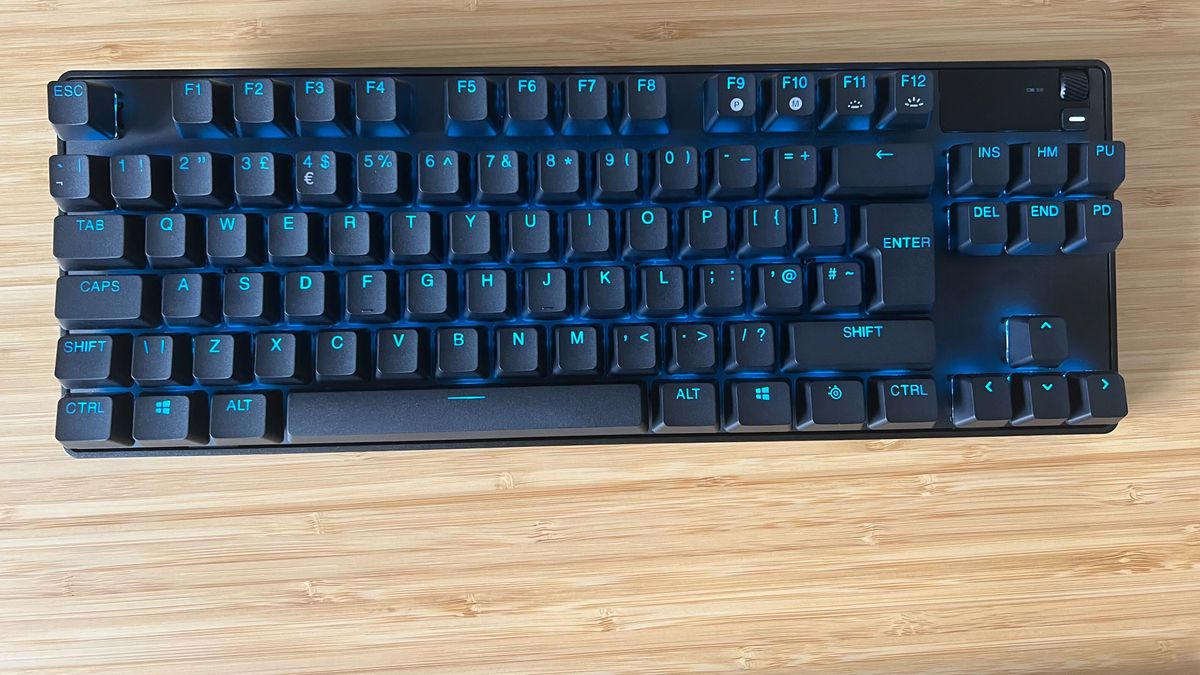12DOVE Verdict
If you need its features and you’re happy to invest, the SteelSeries Apex Pro TKL Wireless is a fantastic keyboard. Those extras don’t add enough to the core experience to make it worth stretching your budget, though. The Apex Pro TKL carries a lofty price tag and takes aim at a niche market with it - if you’re competitive and ready to learn how to make it tick, this is a worthwhile investment.
Pros
- +
Subtle design
- +
Excellent switch customization
- +
Extensive onboard controls
- +
Comfortable wrist rest included
- +
Handy OLED screen
- +
Can be incredibly fast
Cons
- -
Dual-step actuation won’t always be worth it
- -
Hollow typing feel compared to mechanical switches
- -
Priced at the top of the market
Why you can trust 12DOVE
The SteelSeries Apex Pro TKL is a pricey piece of kit, even a year after its release. However, with plenty of additional switch customization features and a rock solid build, the extra cash may well make sense for those looking to invest in a high-end speedster. This is the second generation of Apex Pro TKL, and the first iteration to see a wireless release. Since the 2019 debut, SteelSeries has added its OmniPoint 2.0 adjustable optical switches but the core experience remains similar, with a subtle design, OLED screen, and detachable wrist rest.
It’s certainly packed with functionality, but considering you’d still be spending around $200 / £200 on this device a year after release it kind of has to be. I spent three weeks testing the SteelSeries Apex Pro TKL to see where it sits among the best gaming keyboards available today.
| Price | $249.99 / £229.99 |
| Type | Optical |
| Connection | 2.4GHz / Bluetooth / Wired |
| Size | TKL |
| Switches | SteelSeries OmniPoint 2.0 |
| Keycaps | PBT Doubleshot |
| Media keys | Dedicated |
| Wrist rest | Yes - detachable |
| USB passthrough | No |
Design
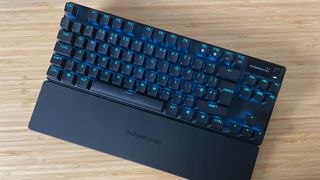
The Apex Pro TKL doesn’t exactly shout with its design. It’s the mellow bass guitarist to the more RGB-laden, angular frontmen of the gaming keyboard world. A simple matte black aesthetic runs across the aluminum alloy plate, plastic base, and PBT doubleshot keycaps.
Aside from the clean, crisp RGB lighting popping through those legends and around each cap, there’s no other visual design elements. The very top of the deck sports a light gray SteelSeries logo, repeated in a glossy stamp on the underside. This isn’t one for those looking to make a statement with their setup, then, but it’s also inline with plenty of other subdued gaming keyboards on the market.
That simple aesthetic belies a pretty solid build quality. The aforementioned aluminum alloy top plate provides a sturdy base to work from, though there was some very minor flex noticeable when directly pushing for it. That’s by no means going to detract from the experience, but considering other decks are more rigid it’s a little disappointing for the price. That’s really splitting hairs, though. The SteelSeries Apex Pro TKL feels stable and secure on the desktop while still keeping things light and versatile.
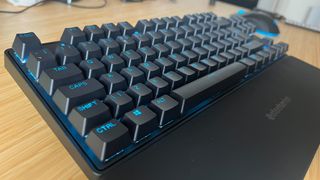
The included wrist rest is a nice touch - despite the higher price tags many decks are reaching these days they rarely include this kind of support. The rest itself is similar to previous iterations, with a thinner profile than you’ll find from Razer but a cooler soft-touch material. I personally prefer SteelSeries’ wrist rests to Razer’s - the textured surface and plusher feel of the snake-brand often gets a bit claustrophobic during longer sessions, whereas here we’ve got a sturdy support with just a little give for the palms.
The TKL form factor means you’re dropping a number pad, but still keeping navigational keys and your arrows. That’s the sweet spot for most productivity / play devices, though it does add a little length compared to a 75% rig. The 35.5 x 13.9 x 4cm dimensions of the Apex Pro TKL
Features
Two features make up a considerable portion of the SteelSeries Apex Pro TKL’s price tag; adjustable actuation and dual-action actuation. Both come from the OmniPoint 2.0 switches installed, themselves optical for a faster response (though a less satisfying typing experience when compared to mechanical switches).
Adjustable actuation has been popping up in a number of gaming keyboards in the last year, and allows for customizable actuation points in each key independently. That means you have control over the sensitivity of your deck without having to buy and swap your switches. The Apex Pro TKL allows you to move between 37 levels of actuation, from a super flyweight 0.2mm to 3.8mm.
That means certain keys can be set to a hair-trigger pull, while others can be much heavier to avoid accidental presses. That range is a little smaller than that of the cheaper (and also customizable) Endgame Gear KB65HE which can take you from 0.1mm to 4mm. Still, that’s an incredibly sensitive switch and I’m not sure how many players will need a lighter touch than 0.2mm. What’s more, these actuation levels can also be set on the fly from the deck itself without the need for the SteelSeries GG software (you can also adjust RGB brightness, set macros, check battery life, and swap profiles directly onboard).
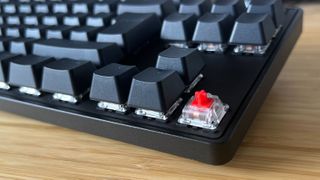
I’m all for adjustable actuation - it’s a functional feature that really makes a difference in gameplay. Dual-action actuation is less of a benefit. This feature allows players to assign one key to two functions depending on how far down it’s pressed. It sounds great, but it’s got a steep learning curve to it and you will be all over the battlefield until you’ve mastered it. I first tested something similar in the Razer Huntsman Mini Analog and loved it for switching between walking and running. The more time I spent with both decks, though, the more I realized that’s really the only thing most players are going to be using this feature for. Unless you’re willing to invest some considerable time getting to know the exact feel of the Apex Pro TKL it’s going to be tricky to reconcile spending serious cash on this deck.
To its credit, SteelSeries has gone the extra mile in terms of attention to detail around these features, though. With all those different actuation points and custom dual-step modes in play, you need a streamlined profile-switching process - and the Apex Pro TKL delivers. A simple Fn + F9 scroll takes you through all your profiles, with a visual indicator from the OLED screen to show you which one you’re currently settled on. That makes switching between work and gameplay incredibly easy.
SteelSeries has actually made good use of that OLED panel as well. Unlike previous iterations, this is used for more than just displaying animations or battery level - you can hook it up to various apps for in-game messages and information and monitor your hardware levels. You can also compress an image into a nightmarish Game Boy Camera-style effigy, but I’d really recommend against it.
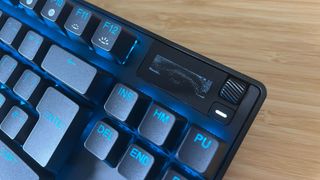
Dedicated media controls (via a volume roller and playback button) and per-key programmability are par for the course in TKL keyboards, and they all run as expected here.
Performance
It shouldn’t be a surprise that a keyboard with a launch price of $250 performs well in-game. The SteelSeries Apex Pro TKL sails through more competitive endeavours with super sensitive switch settings while allowing for a more considered set of actions in slower strategy titles. Competitive players are going to notice a difference in their speed across titles like Apex Legends and CS2. Of course, shortening actuation distances is always going to make for a fast keyboard, but combined with the additional responsiveness of the optical switches you’re getting pro-level times in a deck built with more than speed in mind.
It’s rare to find a competitively paced deck that still offers space and functionality for extra macro support and more comfortable spacing. That’s where the Apex Pro TKL really shines - a high-level player can swap between tournament-level speeds and a more relaxed experience at the tap of a button.
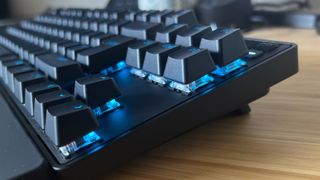
That does come at the expense of typing experience. While I didn’t notice any rattle or pinging across the deck during everyday work use, you don’t have the softness or satisfying thud of a gasket mounted design (a feature available in other gaming keyboards at this price) and the optical switches feel a lot more hollow than their mechanical counterparts. The typing experience is by no means bad - there’s still a nice clack to each bounce and a springy feel across the deck as a whole, but if you’re looking for an enthusiast-level keyboard for typing this isn’t it.
Should you buy the SteelSeries Apex Pro TKL Wireless?
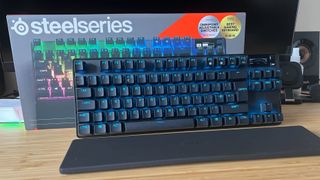
You need to really want the best to be sold by the SteelSeries Apex Pro TKL Wireless. Even though it’s spent some decent time on the shelves this version still generally settles at a $200 / £200 price point. That’s not an unjustified rate, though - it’s just one not many will need to pay.
This is, at its core, an incredibly sophisticated TKL gaming keyboard - going far beyond what others pack into the form factor. This level of customization (both in software and onboard) is rare to find and generally commands a high price tag. If I recommended this to the masses, though, they would be paying for something many won’t use.
In reality, I don’t expect the majority of players to mainline dual-step actuation features. It’s a handy bonus for those who don’t like reaching over for the shift button to run, but it’s not worth the extra $80 / £80 you’re paying on top of other keyboard prices. Customizable actuation is the main player here, and the Endgame Gear KB65HE offers that with a slightly slimmer form factor, and a typing experience that I personally preferred. There’s a nicer level of tension underneath Endgame’s keys, giving each press a more robust feel which was both more comfortable and audibly pleasant than that of the SteelSeries. You’re losing the wireless connection here, but only paying $139.99 / £139.99 for a better switch experience.
A $249.99 / £249.99 MSRP (and similar sales prices today) also puts the Apex Pro TKL straight in the path of the Asus ROG Azoth. The Azoth is the best keyboard I’ve tested to date, and SteelSeries hasn’t changed that. However, I would recommend the Apex Pro to more competitive players just like I’d point anyone more interested in a better typing feel and media control to Asus.
| Specs | SteelSeries Apex Pro TKL Wireless | Asus ROG Azoth | Endgame Gear KB65HE |
|---|---|---|---|
| Price | $249.99 / £229.99 | $249.99 / £269.99 | $139.99 / £139.99 |
| Type | Optical | Mechanical (hot-swappable) | Mechanical (hot-swappable) |
| Connection | 2.4GHz / Bluetooth / Wired | 2.4GHz / Bluetooth / Wired | Wired |
| Size | TKL | 75% | 65% |
| Switches | SteelSeries OmniPoint 2.0 | ROG NX Red Linear | Gateron KS-36B Hall Effect |
| Keycaps | PBT Doubleshot | PBT Doubleshot | PBT Doubleshot |
| Media keys | Dedicated | Dedicated | Dual-Function |
| Wrist rest | Yes - detachable | No | No |
| USB passthrough | No | No | No |
How we tested the SteelSeries Apex Pro TKL Wireless
I used the SteelSeries Apex Pro TKL Wireless for three weeks, running the keyboard across all daily work and play across a range of genres. In that time I primarily tested across CS2, Apex Legends, and Fallout 4, but also played Gears Tactics, A Little to the Left, and The Sims 4 with the deck. For more information on how we test gaming keyboards, check out the full 12DOVE Hardware Policy.
We’re also rounding up all the best wireless gaming keyboards on the market as well as the best Razer keyboards and the best membrane gaming keyboards for cheaper alternatives.

Managing Editor of Hardware at 12DOVE, I originally landed in hardware at our sister site TechRadar before moving over to GamesRadar. In between, I've written for Tom’s Guide, Wireframe, The Indie Game Website and That Video Game Blog, covering everything from the PS5 launch to the Apple Pencil. Now, i'm focused on Nintendo Switch, gaming laptops (and the keyboards, headsets and mice that come with them), PS5, and trying to find the perfect projector.
